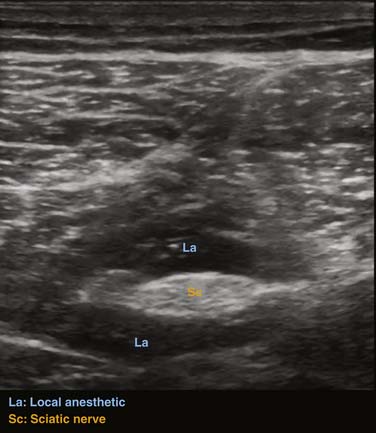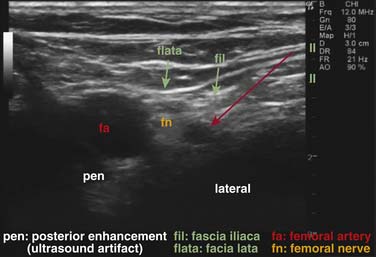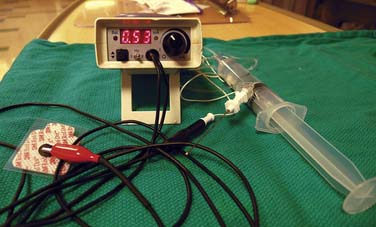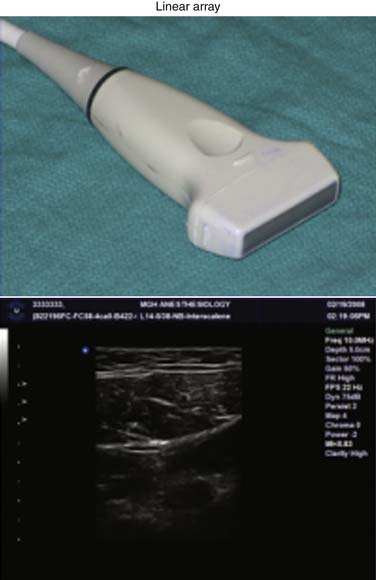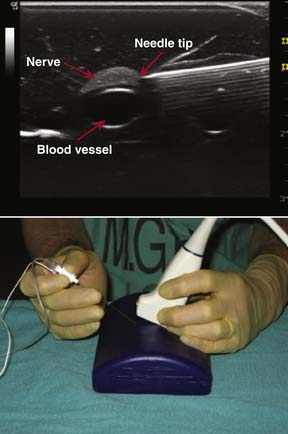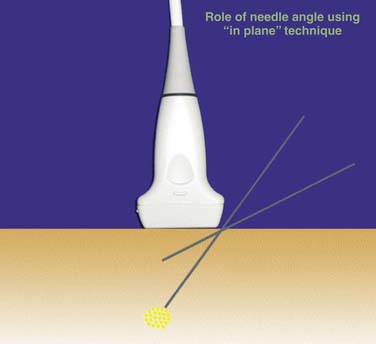24 Ultrasound-Guided Nerve Blocks
The use of ultrasound guidance to perform nerve blocks has been the most exciting development in the field of regional anesthesia in recent years. Instead of blindly advancing the needle toward the target nerve using anatomic landmarks, nerve stimulator, or paresthesia technique, the needle can now be advanced toward its target while imaging both the nerve and the advancing needle. This helps the operator appreciate variations in anatomy and identify structures such as blood vessels or the pleura that should be avoided while advancing the needle. Furthermore, local anesthetic spread around the nerves can be imaged in real time during performance of the block, which can help improve block quality (Fig. 24-1). Also, intraneural and intravascular positioning of the block needle can be identified early, thereby avoiding severe injury.1–3
To successfully use this technique, the detailed knowledge of cross-sectional anatomy, significant skill in advancing the needle, and experience in interpreting the ultrasound images is required. This requires the knowledge of artifacts of ultrasound-guided regional anesthesia such as acoustic enhancement and shadowing (Fig. 24-2).4 In addition, an understanding of basic ultrasound technology is needed to successfully practice ultrasound-guided regional anesthesia.5
The objective of this chapter is to introduce pain management physicians to ultrasound-guided nerve blocks. Although ultrasound guidance for pain management has only recently gained popularity, pain physicians are using this modality more frequently, sometimes in combination with fluoroscopic guidance. Although the block descriptions in this chapter are for regional anesthesia, we believe that the principles are the same when performing these or other peripheral nerve blocks for pain management. Also, we do not recommend abandoning older approaches such as nerve stimulator or paresthesia techniques; instead, we suggest using the ultrasound image as additional information to safely guide your needle toward the target nerve. Clinical practice has shown that intraneural positioning of a needle may not always cause a paresthesia or even nerve stimulation, particularly in diabetic patients.6 A paresthesia or the presence of motor stimulation using a nerve stimulator may alert you that your needle is too close to the nerve when the needle is poorly imaged with ultrasound. In this chapter, we will therefore also describe the role of nerve stimulation and eliciting paresthesias while performing the various nerve blocks (Fig. 24-3).
Some Brief Facts
The higher the frequency, the shorter the wavelength, the better the resolution.
The transducers both transmit and receive ultrasound beams. The reflected ultrasound beams are received by the transducer and are amplified in the scanner. Different tissues alter the waves in different ways. Some scatter, whereas others reflect the waves directly before they return to the transducer as echoes. Bone and gas significantly reflect and scatter the ultrasound waves, whereas fluids produce a weak echo. Strong echoes appear as bright dots or lines on the screen and weak echoes appear as dark areas. The echoes that return from deeper structures are weaker than those from superficial structures and need to be amplified, which is done by the time-gain-compensation amplifier. After picking the appropriate frequency and depth setting you may be able to improve your image prior to starting the nerve block by adjusting the gain. Another useful function of the scanner is Doppler ultrasound. It can be used to detect blood flow in peripheral vessels and help avoid vascular injury while advancing the needle toward the target nerve. For this reason we recommend using the Doppler function to identify vessels close to the nerve before beginning any nerve block.
The two types of transducers typically used for nerve blocks are linear array (Fig. 24-4) and microconvex (curvilinear) transducers (Fig. 24-5). The linear array transducer emits high frequency ultrasound beams as the name states in a linear array and produces scans of rectangular shape. These transducers have a larger footprint than the microconvex probes and are better for scanning superficial structures (e.g., axillary nerve block, interscalene nerve block).
The microconvex transducer has a small footprint and produces scans that are fan-shaped. Thus, larger sections of deeper tissue can be scanned compared to the linear array transducer. The microconvex probes usually also emit lower frequency ultrasound waves. It is therefore used to scan deeper structures (e.g., popliteal nerve block, infraclavicular nerve block) or in cases where only a small space is available for scanning (due to its smaller footprint).
To successfully perform an ultrasound-guided nerve block, the nerve structures that are to be blocked and the structures that should be avoided, such as pleura and blood vessel, need to be clearly identified. The ultrasound probe is typically placed where the needle insertion point would be in a conventional block technique. The needle is then inserted several centimeters from the probe site and advanced in plane of the ultrasound beam (Fig. 24-6). This allows continuous visualization of the needle as a hyperechoic (white) line. This is sometimes challenging particularly when blocking nerves in deeper tissues. However, it is of paramount importance for safely performing the block to image the needle clearly, particularly the needle tip. The needle can easily veer out of plane while advancing, which can lead to significant misjudgment of the location of the needle tip (Fig. 24-7).

Figure 24-7 Using the in plane needle advancement technique as shown in Figure 24-6. The needle is placed intravascularly. A, intravascular position of the needle in the “blue phantom” model. B, same needle position as on the right, however, the ultrasound probe is placed out of plane. The virtual needle tip appears far away from the vessel. The real needle tip is, in fact, intravascular.
If this should occur we recommend pulling the needle back to just under the skin and then re-advancing it. Optimal imaging of the needle may also require moving the ultrasound transducer from side to side, tilting it, or rotating the probe using a slow and steady motion. In addition, the flatter the angle of approach, the more easily the needle can be visualized.7 It is sometimes helpful to image the needle at a flat angle before advancing the needle at the appropriate angle for the target nerve (Fig. 24-8).
Preparing for Ultrasound-Guided Nerve Block
Before performing an ultrasound-guided nerve block the skin needs to be prepped with an alcohol solution and the ultrasound probe should be covered with a sterile drape. For teaching purposes, the sterile cover is not shown in the following images because this would obscure the transducer position. Then, an ultrasound transducer needs to be selected. For very deep structures, a microconvex or a low-frequency linear transducer should be used and for superficial structures, a linear transducer should be chosen. Next, the frequency on the scanner needs to be adjusted (e.g., 10 to 14 mHz for superficial structures, or 5 to 9 mHz for deep scanning). Subsequently the depth on the scanner needs to be set to about 1 to 2 cm deeper than the suspected nerve depth because the image size of the area of interest will be amplified if your depth setting is optimized. Now the gain (amplification) of your ultrasound signal should be adjusted which will frequently improve the image quality and give you better contrast. Always perform the blocks in a comfortable position for the patient and yourself (e.g., sitting position).8
Stay updated, free articles. Join our Telegram channel

Full access? Get Clinical Tree


